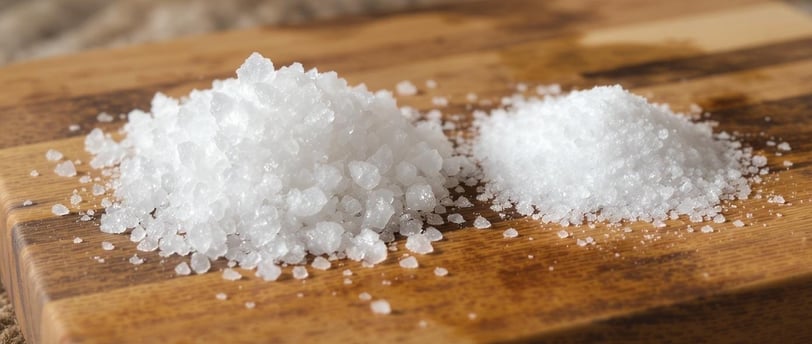Salt
It’s all about knowing your salt
RECIPESKITCHEN
6/8/20252 min read


Salt: It's All About the Salty, Not So Much the When or What
My Salt Squad: The Go-To's
In my kitchen, you'll find two trusty companions: a big tub of regular table salt for everyday cooking and a box of Diamond Crystal Kosher Salt for those moments when texture and taste really matter. You can find table salt and Diamond Crystal that I use here..
When Timing Matters (and When It Doesn't)
Okay, let's get one thing straight: there are exceptions to the "when" rule. Dry-brining a steak, for example, is a prime example of when timing is crucial. Applying salt well in advance allows it to penetrate the meat, resulting in a more flavorful and juicy final product.
But for most dishes, like soups, stews, sauces, and sautéed vegetables, the timing of your salt addition is far less critical. Whether you add it at the beginning, middle, or end, the salt will eventually dissolve and distribute its flavor throughout the dish.
Salt Varieties: A Grain of Truth
Now, let's talk about salt types. Table salt, sea salt, kosher salt, Himalayan pink salt – the options seem endless. But chemically, they're all primarily sodium chloride (NaCl). The main differences lie in their crystal size, shape, and the presence of trace minerals.
Table Salt: Finely ground, often with iodine added. Its density means it measures differently than other salts.
Sea Salt: Made by evaporating seawater, it retains trace minerals that some say add complexity to the flavor.
Kosher Salt: Coarse-grained, additive-free, and prized for its clean, pure flavor. Diamond Crystal is less dense than other kosher salts, so it's important to note if a recipe calls for a different brand.
Himalayan Pink Salt: Mined from ancient salt deposits, its pink hue comes from trace minerals like iron.
The Texture Effect
While the flavor differences between salt types are often subtle, the texture can make a noticeable impact. Think about a perfectly ripe tomato sprinkled with coarse sea salt. The occasional burst of salty crunch against the juicy sweetness is a sensory delight. That same coarse salt, dissolved in a soup, simply disappears.
Find Your Salt Soulmate
Ultimately, the best salt is the one you'll use consistently. Find a salt that fits your budget and stick with it. As you cook, you'll develop an intuitive sense of how much salt to add to your recipes. This consistency is far more important than chasing after the "perfect" salt.
So, go forth and salt with confidence! Don't get bogged down in the minutiae. Focus on developing your palate and learning how salt enhances the flavors of your favorite dishes.
Just a heads-up: some of the links on this page are affiliate links. This means that if you click on them and make a purchase, I may earn a small commission at no extra cost to you. I only recommend products or services that I genuinely believe in and have personally used or researched. Your support through these links helps me keep creating content, and I really appreciate it!
Explore
Discover kitchen tools and recipes from everywhere.
Savor
Cook
Hello@simmerspace.com
© 2025. All rights reserved.